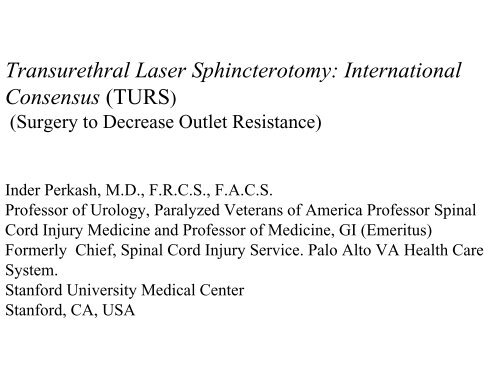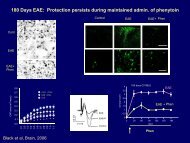Transurethral Laser Sphincterotomy - Paralyzed Veterans of America
Transurethral Laser Sphincterotomy - Paralyzed Veterans of America
Transurethral Laser Sphincterotomy - Paralyzed Veterans of America
Create successful ePaper yourself
Turn your PDF publications into a flip-book with our unique Google optimized e-Paper software.
<strong>Transurethral</strong> <strong>Laser</strong> <strong>Sphincterotomy</strong>: International<br />
Consensus (TURS)<br />
(Surgery to Decrease Outlet Resistance)<br />
Inder Perkash, M.D., F.R.C.S., F.A.C.S.<br />
Pr<strong>of</strong>essor <strong>of</strong> Urology, <strong>Paralyzed</strong> <strong>Veterans</strong> <strong>of</strong> <strong>America</strong> Pr<strong>of</strong>essor Spinal<br />
Cord Injury Medicine and Pr<strong>of</strong>essor <strong>of</strong> Medicine, GI (Emeritus)<br />
Formerly Chief, Spinal Cord Injury Service. Palo Alto VA Health Care<br />
System.<br />
Stanford University Medical Center<br />
Stanford, CA, USA
I have no financial interest or relationships to<br />
disclose.<br />
Inder Perkash,MD
Learning Objectives<br />
At the conclusion <strong>of</strong> this activity, the participant will be able to:<br />
• A. Surgical management <strong>of</strong> Neurogenic bladder in Patients who cannot<br />
self catheterize and drain bladder.<br />
• B. Management <strong>of</strong> spinal injured patients with autonomic dysreflexia<br />
particularly if it is not amenable to adequate control with medical<br />
management.<br />
• C. Role <strong>of</strong> transurethral sphinterotomy to prevent and manage<br />
complications such as vesico-ureteral reflux and stone disease.
Indications <strong>of</strong> TURS:<br />
The primary indication for TURS is<br />
in those individuals who have<br />
elevated residual urine volumes in<br />
the presence <strong>of</strong> good but involuntary<br />
detrusor contraction and who have<br />
failed conservative management.<br />
(Perkash, et al, Consensus Incontinence 2002, W.H.O.)
Following an adequate TURS, an<br />
improvement in bladder emptying<br />
and stabilization <strong>of</strong> the upper urinary<br />
tract and amelioration <strong>of</strong> autonomic<br />
dysreflexia can be reasonably<br />
expected in 70-90% patients.<br />
Wein et al; Urology 1976,8,432<br />
Perkash; J. Urol., 124, 249, 1980
Goals <strong>of</strong> <strong>Sphincterotomy</strong> (TURS)<br />
- Stabilize and or improved renal function<br />
- Lower detrusor leak point pressure<br />
- Prevent urosepsis/stone disease<br />
- Stabilize or eliminate V.U. reflux<br />
- Eliminate indwelling catheter<br />
- Ameliorate - prevent Autonomic<br />
Dysreflexia
Indications; TURS:<br />
1. Repeated Autonomic Dysreflexia typically<br />
in Tetraplegics with poor hand<br />
function.<br />
2. Repeated UTI. (symptomatic)<br />
3. Difficult catheterization due to stricture, or<br />
a false passage.<br />
4. Secondary bladder neck obstruction: TUIP.<br />
Bladder Neck- Ledge,median lobe.<br />
(difficult catheterization)
Bladder Neck Ledge. L-ledge, B-Bladder, U-Urethra.<br />
N-narrow bladder Neck<br />
B.N. Ledge
Bladder Neck<br />
Ledge:<br />
•162/339 (47%) SCI had ledge and<br />
only2/110 (1.8%) non SCI showed<br />
posterior bladder neck ledge. @28% <strong>of</strong> SCI<br />
patients had a significant ledge (>0.5cm)<br />
and they were on Intermittent<br />
Catheterization and were associated with<br />
Detrussor sphincter dyssenergia .(p<br />
value
Indications: TURS (Cont’d)<br />
5. Inadequate bladder drainage<br />
resulting in<br />
- upper tract changes<br />
- vesico-ureteral reflux/stone diseae.<br />
- renal function deterioration<br />
6. Prostate-ejaculatory reflux<br />
(Repeated epididymo-orchitis)
TURS: Surgical Techniques:<br />
1. Knife electrode (Diathermy)<br />
12 O’clock incision<br />
- Colling's Knife<br />
- Perkash ACMI Knife
Diathermy TURS, Problems:<br />
- Op & post Op secondary bleed<br />
- clot retention<br />
- prolonged catheterization<br />
- impotence<br />
- stricture urethra (bulbous)<br />
- reoperation 30-60%<br />
1.Neil et al, Neurourol.Urodyn. 1995<br />
2. Juna et al, Neurourol. Urodyn. 1995)
Majority failures <strong>of</strong> TURS are due to<br />
inadequate surgery.<br />
Additional bladder neck incision in<br />
14% patients following 12 O’clock<br />
TURS.<br />
(Neil, et al; Neurourol.Urodyn. 1995)
Technique: <strong>Laser</strong> Physics:<br />
**Free beam Nd:YAG: Produces coagulative necrosis,<br />
for TURS need to start in a contact mode for incision<br />
and vaporization.)<br />
* Contact laser Nd:YAG; SLT..or even HO:YAG in a<br />
contact mode ….for vaporization
Contact <strong>Laser</strong>: Chisel Crystal (SLT)<br />
*20-25 watts<br />
* For adequate cutting 35-40 watts<br />
Perkash, J. Urol. 152, 2020, 1994<br />
Perkash, J. Urol. 24, 227, 1997
Holmium:YAG <strong>Laser</strong> (HO:YAG):<br />
(Widely Used)<br />
- Pulsed Mode wave length 2100 nm<br />
- High water absorption<br />
- Tissue effects within 3 mm <strong>of</strong> fiber<br />
- Touch the tissue to cut…<br />
- Withdraw 1-2 mm for controlled<br />
homeostasis.<br />
- Light absorption depth - less than<br />
0.5 mm.
HO:YAG <strong>Laser</strong> (15 W – 60 Watts)<br />
- Quarts laser fibers<br />
- 220, 325, 550 and 1000 um fibers<br />
- (Vaporization bubble at the fiber tip<br />
increases with fiber diameter)
HO:YAG <strong>Laser</strong>:<br />
- Energy 0.2 to 4.0 J per pulse<br />
(pulse duration up to 500 microsecond)<br />
- Frequency 5 to 40 Hz (pulses per<br />
second)<br />
For TURS max. 1.2 J x 10 Hz (12 W)<br />
was used in an almost a contact mode)
External Urethral<br />
Sphincter
External Urethral Sphincter
HO:YAG TURS.<br />
HO:YAG Fiber
TURS <strong>Laser</strong> Incision
Caculus in Bladder<br />
Calculus . In Bladder Neck<br />
TURS<br />
<strong>Laser</strong> Vaporizationbladder<br />
neck.
Failed TURS : Bladder Neck not incised : Severe Aut. Dysreflexia
HO:YAG Vaporization… Scar Tissue
Post TURS with additional incisions.
Post Diathermy Stricture : <strong>Laser</strong> Incision
Fig.2A: VCUG before<br />
surgery. (Patient Z)<br />
stricture
Fig.2B: 7 years after<br />
vaporization. (Patient Z)
ACMI-‘Perkash’ Knife for TURS and TUIP.
TUIP-incisions… Bladder Neck Fibers
TUIP Incisions….3 and 9 O'clock
1. Bladder Neck Stenosis….
2. Circumferential Vaporization <strong>of</strong> Bladder Neck
Contact <strong>Laser</strong> TURS = 99 Patients<br />
(HO = 9 Patients)<br />
TUIP & TURS = 21 Patients<br />
120
<strong>Laser</strong> Failures: 14 % Patients (9 Year follow up)<br />
*Areflexic Bladder 4 Patients<br />
* Stricture Urethra 5 (Previous diathermy TURS)<br />
* Post Bacl<strong>of</strong>an pump 1<br />
* Severe Spasticity 3<br />
* Inadequate TURS 4 (learning phase)<br />
= 17 Patients<br />
(12 relasered within 1 st year)<br />
* Relasered Patients: Minimal Bleeding (Less than 25<br />
ml).
****Avoid TURP with TURS<br />
(leakage <strong>of</strong> urine around catheter-indwelling and on<br />
straining during ICP)
Successful Outcome TURS:<br />
- Little or no bleed<br />
- Catheter 24 hours<br />
- Leak point pressure below 40 cm H 2 0<br />
- Repeat surgery
46 patients. Significant drop in maximum systolic BP.<br />
( p value 0
46 patients. Significant drop in maximum diastolic BP.<br />
(P value 0
Conclusions:<br />
*<strong>Transurethral</strong> resection <strong>of</strong> the<br />
external urinary sphincter (TURS) is a<br />
reasonable option to adequately drain<br />
the bladder to prevent urologic<br />
complications in the spinal cord<br />
injury or myelopathic disorders in the<br />
male patients.<br />
(Perkash, et al, Consensus Incontinence 2002 W.H.O.)
*The procedure helps to decrease urinary ouflow resistance<br />
due to detrusor- sphincter dyssynergia,<br />
and ameliorates autonomic dysreflexia*<br />
* Perkash, J.Urol. 2007,177,1026-129.<br />
*It reduce the intravesical voiding pressure medicated by<br />
bladder contractions again a dyssenergic contracted<br />
external urethral sphincter, and prevents upper tract<br />
complications ;V-U reflux , infections and stone disease;<br />
**This improves quality <strong>of</strong> life, particularly <strong>of</strong><br />
Quadriplegic Patients who cannot self catheterize and also<br />
suffer from DSD.
Difficult Ext. Condom Drainage:<br />
(Short Phallus: Failure 10-15%)<br />
* Consider Penile Implant<br />
(Perkash, Paraplegia, 5, 327, 1992)
TURS: other Options.: ( Failed Int. Cath.<br />
- Urethral stents<br />
- Suprapubic catheter<br />
- Diversions, neo bladder, ileostomy,<br />
- Bladder stimulation
















